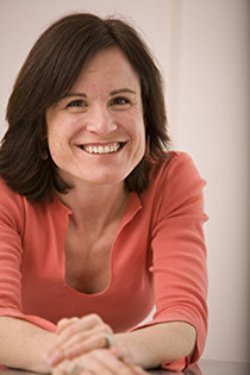Title of the work
Country of the First Edition
Country/countries of popularity
Original Language
First Edition Date
First Edition Details
Joan Holub, Play Nice, Hercules! "Mini Myths", New York: Abrams Appleseed, 2014, 22 pp.
ISBN
Official Website
abramsbooks.com (accessed: July 26, 2018).
Genre
Didactic fiction
Mythological fiction
Picture books
Target Audience
Children (aged c. 0–4)
Cover

We are still trying to obtain permission for posting the original cover.
Author of the Entry:
Sonya Nevin, University of Roehampton, sonya.nevin@roehampton.ac.uk
Peer-reviewer of the Entry:
Susan Deacy, University of Roehampton s.deacy@roehampton.ac.uk
Dorota Mackenzie, University of Warsaw, dorota.mackenzie@gmail.com

Photo courtesy of Joan Holub.
Joan Holub
, b. 1956
(Author)
Joan Holub is a prolific children's author from the USA. Graduated from college in Texas with a fine arts degree. Worked as an art director at Scholastic trade books in New York. She has written and/or illustrated over 150 children's books. She has developed a range of series for teenagers on mythological themes: Goddess Girls, set in Mount Olympus Academy, Grimmtastic Tales series, set in Grimm Academy, Thunder Girls, about Norse gods set in Asgard Academy, and Heroes in Training, in which the male Greek gods, as very young men, set out on a range of adventures. For pre-school children, Jan Holub has written on a range of topics including several works with religious and historical themes. These include: This Little President; This Little Trailblazer, Hooray for St. Patrick’s Day!, and Light the Candles: A Hanukkah Lift-the-Flap Book. Joan Holub trained in fine art and worked as an art director at a graphic design company before becoming a children's illustrator and then author.
Sources:
Official website (accessed: July 2, 2018).
Profile at the penguinrandomhouse.com (accessed: July 2, 2018).
Profile at the simonandschuster.com (accessed: July 2, 2018).
Bio prepared by Sonya Nevin, University of Roehampton, sonya.nevin@roehampton.ac.uk and Allison Rosenblum, Bar-Ilan University, allie.rose89@gmail.com and Ayelet Peer, Bar-Ilan University, ayelet.peer@gmail.com
Questionnaire
1. What drew you to writing / working with Classical Antiquity and what challenges did you face in selecting, representing, or adapting particular myths or stories?
I learned to love Greek and Norse mythology in elementary school. I’m very comfortable adapting the framework of an existing myth or fairy tale by pushing it into a different setting, adding humor, and/or building in a nonfiction component. Staying true to the essential core of each myth along the way is important to me. A young Goddess Girls reader once told me she enjoyed the series because she “learned something”. In other words, while she liked being entertained, she appreciated that her familiarity and factual understanding of the original myths was broadened at the same time.
2. Why do you think classical / ancient myths, history, and literature continue to resonate with young audiences?
Kids have questions about their world. So it’s interesting to them to learn how ancient Greeks and other cultures answered questions about how their world worked in exciting tales of heroes and beasts. How did the sun cross the sky? In a chariot drawn by the god Helios. What caused night? The goddess Nyx’s starry cape covered the sky. Thrilling stories of courage and danger, such as Heracles’ twelve labors, the Trojan Horse, and the Argonauts never go out of style.
3. Do you have a background in classical education (Latin or Greek at school or classes at the University?) What sources are you using? Scholarly work? Wikipedia? Are there any books that made an impact on you in this respect?
I have an entire shelf of mythology resource books. Some of my favorite go-to sources are the Scholastic Mythlopedia series, Edith Hamilton’s Mythology, Timeless Tales of Gods and Heroes, and www.theoi.com (accessed: May 28, 2018).
4. How concerned were you with "accuracy" or "fidelity" to the original? (another way of saying that might be – that I think writers are often more "faithful" to originals in adapting its spirit rather than being tied down at the level of detail – is this something you thought about?)
Each book in the Goddess Girls series (ages 8–12, Simon and Schuster) and Heroes in Training series (ages 7–10, Simon and Schuster) is a retelling of one or two Greek myths, with a twist. We stay as true as possible to the core bones of an original myth in order to give young readers a good understanding, but we include kid situations and humor to entertain. As an example, in Goddess Girls #1: Athena the Brain, Athena is summoned to attend Mount Olympus Academy, where Zeus is the principal. MOA teachers include Mr. Cyclops, who teaches Hero-ology, a class where students are graded on their abilities to maneuver small hero figures such as Odysseus, around a gameboard to enact the Trojan War, etc. Meanwhile, Athena, who is the goddess of invention among other things, inadvertently turns mean-girl Medusa’s hair to snakes and gives her the power to turn mortals to stone by means of a shampoo-like invention called Snakeypoo at the MOA invention fair.
5. Are you planning any further forays into classical material?
Suzanne Williams and I have written a new middle grade series called Thunder Girls (accessed: May 28, 2018), which is a twist on Norse mythology featuring strong girl characters. The first book Freya and the Magic Jewel releases May 2018 for ages 8–12, published by Simon and Schuster.
Prepared by Allison Rosenblum, Bar-Ilan University, allie.rose89@gmail.com and Ayelet Peer, Bar-Ilan University, ayelet.peer@gmail.com

Photo courtesy of Leslie Patricelli.
Leslie Patricelli (Illustrator)
Leslie Patricelli is an illustrator based in Hailey, Idaho, USA. Patricelli majored in communications from the University of Washington, and took classes at the School of Visual Concepts in Seattle. She first worked as an advertising copywriter. Her work is primarily aimed at books for a preschool audience and carried out for Candlewick Press. She has recently begun branching out into writing children's literature. She created Rover the dog for Windows XP help.
Sources:
Official website (accessed: January 13, 2018).
Profile at the goodreads.com (accessed: June 26, 2018).
Bio prepared by Allison Rosenblum, Bar-Ilan University, allie.rose89@gmail.com and Sonya Nevin, University of Roehampton, sonya.nevin@roehampton.ac.uk
Summary
The main character, 'Hercules', is a pre-school-aged child in the modern era. His father tells him to 'Play nice', but he answers that he is 'not nice. [He] is strong'. Hercules knocks over a toy monster and scatters toy soldiers. He then knocks down blocks that his little sister is playing with. Hercules is remorseful about making his sister cry. He rebuilds the pyramid of blocks. An image then suggests that his sister is about to knock them over; the story ends with the two reconciled and sharing a hug. A one-page summary of the myth of Hercules' labours follows, written at a somewhat different register, as if for an adult or older child (of c. 4–8).
Analysis
This book is part of a beautifully illustrated series that creatively transposes ancient myths into the real-life scenarios faced by pre-school-aged children. Subtle ancient-style features are included in the design of each volume in the series: a brightly-coloured Greek key runs vertically along the cover beside the spine; the series name is written on a scroll, with the 'S' of 'myths' written in a jagged, inscription-like style; on the spine, the main character is shown standing upon a Doric column, with the name of the book written on the column, and the image of the character atop a column is repeated in the interior title-page.
A theme, or moral lesson, is included in each volume in the fore-notes in the style of a dedication. In Play Nice, Hercules!, the dedication is 'To fixing mistakes with strength and kindness.' This plays out in the book through Hercules rebuilding his sister's block pyramid – an act of kindness if not of strength. It is implied that Hercules learns that his strength must be tempered by kindness and consideration. It is arguable that the child characters learn only to counter aggression with aggression, as their relationship is shown to be restored only once the sister knocks down Hercules' pyramid; however the purpose of this analysis is not to discuss the book's effectiveness at communicating moral lessons. Antiquity has provided a model here, with Hercules' destruction of his sister's playthings as a stand-in for ancient Hercules' destruction of his family, while the rebuilding of the toy-block pyramid reflects the labours undertaken in a quest for forgiveness for that act of violence. This connection is reinforced through naïve illustrations upon the blocks which each represent a labour:
- Nemean lion – lion head
- Hydra – snake
- Golden-antlered deer – stag
- Boar – boar's head
- Augean stables – sheep
- Stymphalian birds – blue-bird
- Bull of Crete – long-horn bull
- Diomedes' horses - horse
- Amazon belt – gold-centered belt
- Geryon's cattle - cow
- Golden Apples – apple
- Cerberus – dog
The summary of the myth at the end of the book offers a list of the labours, meaning that even adults who do not immediately recognise the significance of the blocks' illustrations are likely to identify it once they have read the summary. This may simply enrich their experience of the book, or potentially enable them to draw out the significance in conversation with the child-reader.
Other aspects of antiquity are drawn into the illustrations. The monster Hercules strikes is a cyclops, while the toy soldiers that he scatters are depicted in an ancient style, with some open-face plumed helmets and some Corinthian style ones, all holding shields and either swords or spears.
This series introduces very young children to some of the names and images associated with antiquity, preparing them for encountering these images and characters again in different contexts. At a very fundamental level, these books also act on and communicate the idea that ancient mythology contains concepts that can help in children's development – social, moral, and emotional. The families in the books come from a range of ethnicities, with the implication that classical myths can be for anyone, regardless of their ethnic background. Children at the outer edge of the age bracket for these books can also enjoy the summary that comes at the end of the book, which creates the opportunity for an early encounter with the sophisticated concept of characters reappearing in different contexts and stories, and stories working on different levels – things which are likely to stimulate thought and a nuanced approach to stories and story-telling.
Further Reading
Blanshard, Alastair, Hercules, a Heroic Life, London: Granta Books, 2006.
Rawlings, Louis, and Hugh Bowden, Herakles and Hercules. Exploring a Graeco-Roman Divinity, London: Classical Press of Wales, 2005.
Stafford, Emma, Herakles, London: Routledge, 2012.
Weinlich, Barbara, "The Metanarrative of Picture Books: ‘Reading’ Greek Myth for (and to) Children", in Lisa Maurice, ed., The Reception of Ancient Greece and Rome in Children’s Literature. Heroes and Eagles, Brill: Leiden, 2015.


